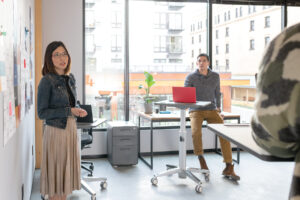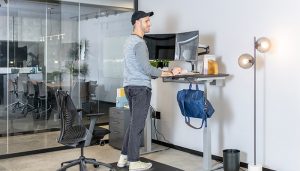As the global health situation evolves, employees will continue to work differently. Some will remain working at home full or part time. Others will return to their once familiar corporate offices. All employees—no matter where they work—need safe, ergonomic workspaces to strive toward your company goals.
Keeping employees engaged and productive remains top of mind for leaders in every industry. This starts by ensuring employees that stay working from home have the tools they need to work comfortably, while planning a thoughtful return to work for others that can evolve in the weeks and months to come.
The Centers for Disease Control and Prevention offers many guidelines tailored toward businesses. including cleaning recommendations and other ways to protect workers from the further spread of COVID-19. In addition to these recommendations, we’ve put together five tips for helping keep your employees safe and healthy as they return to the office.
Support a healthy workplace
 There’s still a long way to go in fully understanding COVID-19 and rolling out broader testing. For organizations, a simple way to help protect employees at the workplace is to offer temperature checks before they enter the building.
There’s still a long way to go in fully understanding COVID-19 and rolling out broader testing. For organizations, a simple way to help protect employees at the workplace is to offer temperature checks before they enter the building.
Mobile thermal imaging carts are a great way to detect a temperature for both employees and visitors to ensure anyone already experiencing a fever heads home.
In your facility, make cleaning supplies readily available and implement additional deep cleaning procedures for overnight crews. Don’t forget that shared resources like printers and filing cabinets need a thorough wipe-down. Limit access to common places like the employee cafeteria and avoid close interactions with other employees.
Find ways to spread out
Social distancing guidelines stipulate a six-foot distance between people who do not live together. That presents a significant challenge for many organizations using standard cube configurations or benching systems. Work with facilities to rethink your office environment and find ways to spread out. You’ll probably lose dedicated workspace in the process, so consider flexible work schedules that allow employees to share the same workstation on different days.
Make sure each desk and accessories are sanitized daily to help prevent the spread of germs and consider offering additional work-from-home hours for employees who do not need to be in the office. Avoid holding group meetings in conference rooms or spaces that compromise social distancing rules. If the weather cooperates, head outside for some fresh air and a well-spaced conversation.
Invest in flexible office furniture
Keeping your employees comfortable at work can also help keep them healthy—both physically and mentally. Promote their holistic health with ergonomic office solutions, like sit-stand desks, mobile workstations and adjustable monitor arms. The right fit will also enhance their focus and productivity, which are welcomed benefits in these uncertain times. Look for professional-grade designs with advanced cycle and weight testing, so you know you’re making a worthwhile investment that promotes user safety.
Flexible office furniture can quickly transform cubicle rows or benching systems into open office designs that meet social distancing requirements. Plus, they’re easily adaptable to match the fluidity of the current times. They can be easily reconfigured for each workday, project or team with numerous opportunities for personalization.
Don’t forget home office workers

Outlining a thorough return to work plan is a key focus area for company leaders, but it’s important to remember that some employees will remain working from home. It may be because of new limitations in your reworked office space or because of personal health concerns. Regardless of the reason, these at-home workers need access to the same flexible office furniture as non-remote employees.
Living room couches and dining room tables aren’t designed for comfortable working. If you haven’t already, determine a stipend amount that home workers can use to purchase height-adjustable desks and monitors. There are many options on the market, so try narrowing it down to a few suggested products for laptop users, taller employees, single monitor workers or those who prefer a double or triple monitor set-up. Be sure to also share tips for adding movement to their work-from-home routine.
Put your people first
It’s tempting for organizations to run full-speed ahead in their return-to-work plans to ramp up production and race toward pre-pandemic goals. Recognize that we’re all operating in a new normal, from the entry-level employees all the way up to your CEO. Send out regular pulse surveys to gather employee feedback on their workstation set-up, schedule and anything else related to your company’s pandemic response.
Be open to implementing their feedback and evolving your processes alongside new research and changing health recommendations. Employees are the heart and soul of any successful organization, and they need to be on board with changes in these unprecedented times.
Remember, each organization and employee base is unique. Choose which strategies work for your workplace culture to help keep your employees comfortable, productive and healthy wherever they choose to work.
View all of Ergotron’s COVID-19 resources on www.ergotron.com.






